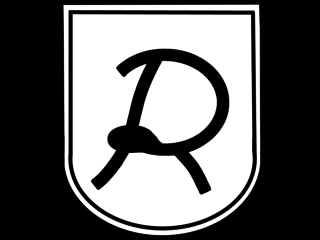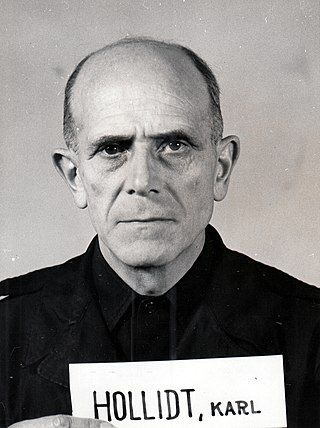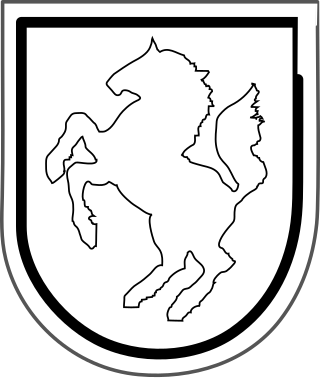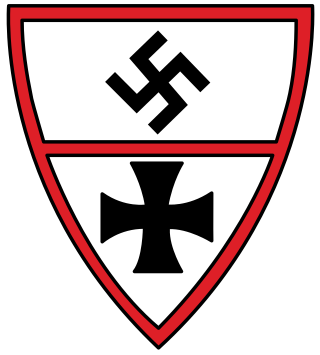Mountain Corps Norway was a German army unit during World War II. It saw action in Norway and Finland.

The 3rd Mountain Division was a formation of the German Wehrmacht during World War II. It was created from the Austrian Army's 5th and 7th Divisions following the Anschluss in 1938.
XVIII. Armeekorps was formed in Salzburg, Austria, on 1 April 1938, following the Anschluss of Austria into the German Reich. During the life of the XVIII. Armeekorps, they took part in the Polish campaign, Fall Weiss, and the campaign in the West 1940, and performed occupation duties in France. On 30 October 1940, the Corps gave up some elements to newly forming XXXXIX. Gebirgskorps, and on 1 November, they re-designated the Korps name to XVIII. Gebirgskorps, under which it participated to Operation Marita, the invasion of Greece in spring 1941.

The 32nd Infantry Division of the German Army was mobilized on 1 August 1939 for the upcoming invasion of Poland. At that time, it consisted of the usual German Infantry Division elements: three infantry regiments of three battalions each, one three-battalion regiment of light artillery, one battalion of heavy artillery, a Panzerjäger (anti-tank) Battalion, a reconnaissance (Aufklärungs) Battalion, a Signals Battalion, a Pioneer (Engineer) Battalion, and divisional supply, medical, and administrative units.

Hans Kreysing was a German general who commanded the 3rd Mountain Division and the 8th Army. He was a recipient of the Knight's Cross of the Iron Cross with Oak Leaves and Swords.

The 52nd Infantry Division was an infantry division of the German Heer during World War II, which would become the 52nd Field Training Division in December 1943 and then the 52nd Security Division in April 1944.

General der Gebirgstruppe was a category of German Army three-star, a new example of the traditional German 'General der rank introduced by the Wehrmacht in 1940, comparable to the NATO grade OF-8.

Karl-Adolf Hollidt was a German army commander in World War II who was subsequently convicted of war crimes. He was a general (Generaloberst) in the Wehrmacht of Nazi Germany who commanded the 6th Army.
II Army Corps was a corps in the German Army during World War II.

V Army Corps was a corps in the German Army during World War II.

German XI. Corps was a corps in the German Army during World War II.
VII Army Corps was a corps in the German Army during World War II. It was destroyed in August 1944 during the Jassy–Kishinev Offensive.

VIII Army Corps was a corps in the German Army during World War II. It was destroyed during the Battle of Stalingrad and reformed in mid-1943.
German XXIII. Corps was a corps in the German Army during World War II.
German XIII. Corps was a corps in the German Army during World War II. It was destroyed during the Lvov–Sandomierz Offensive and reformed in late 1944.
XXXXIX Mountain Corps was a mountain warfare corps of the German Army during World War II.
XII Army Corps was a corps in the German Army during World War II. It was formed in the Wehrkreis XII recruitment and training district in Wiesbaden in October 1936 and was mobilized before the outbreak of war at the end of August 1939.
XIII Army Corps was a corps of the German Army during World War II. Made up of several divisions, which varied from time to time, it was formed in Nuremberg on 1 October 1937.

The XXIV Army Corps was a unit of the German Army during World War II. The unit was re-designated several times; originally being Generalkommando der Grenztruppen Saarpfalz, later Generalkommando XXIV. Armeekorps, then XXIV. Armeekorps (mot.) and finally XXIV. Panzerkorps.

XXXXIII Army Corps was a corps in the German Army during World War II.











